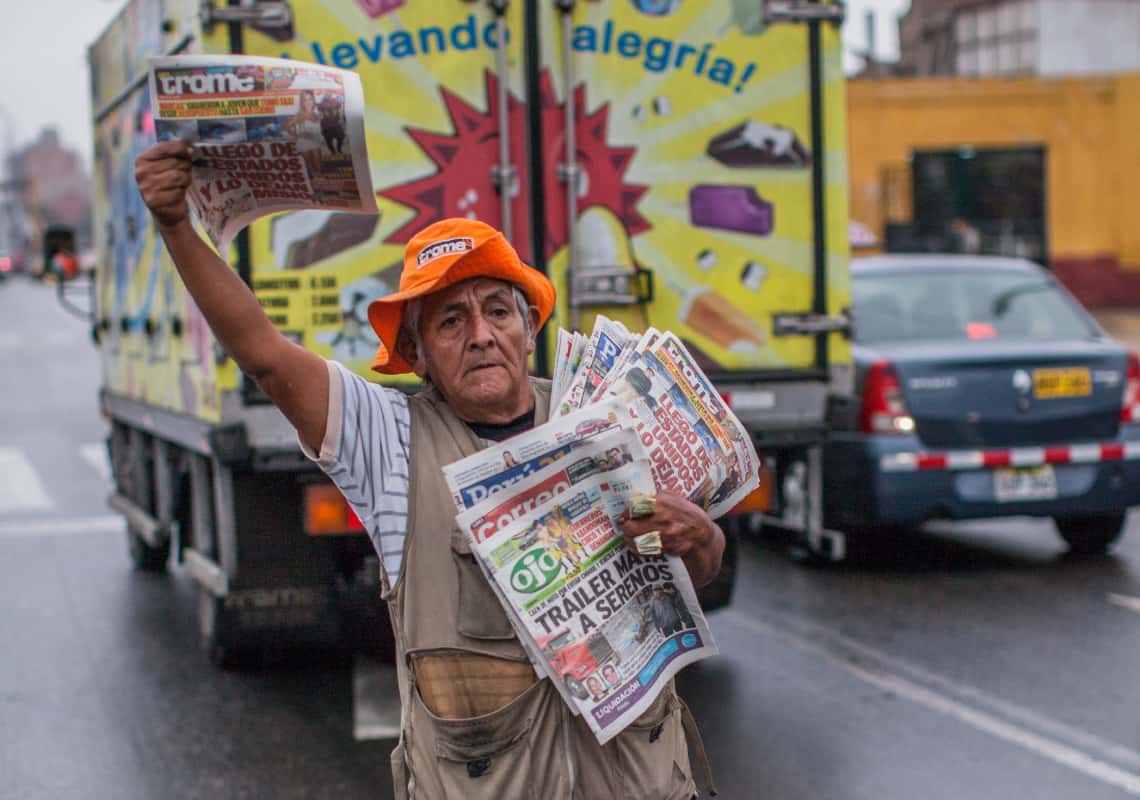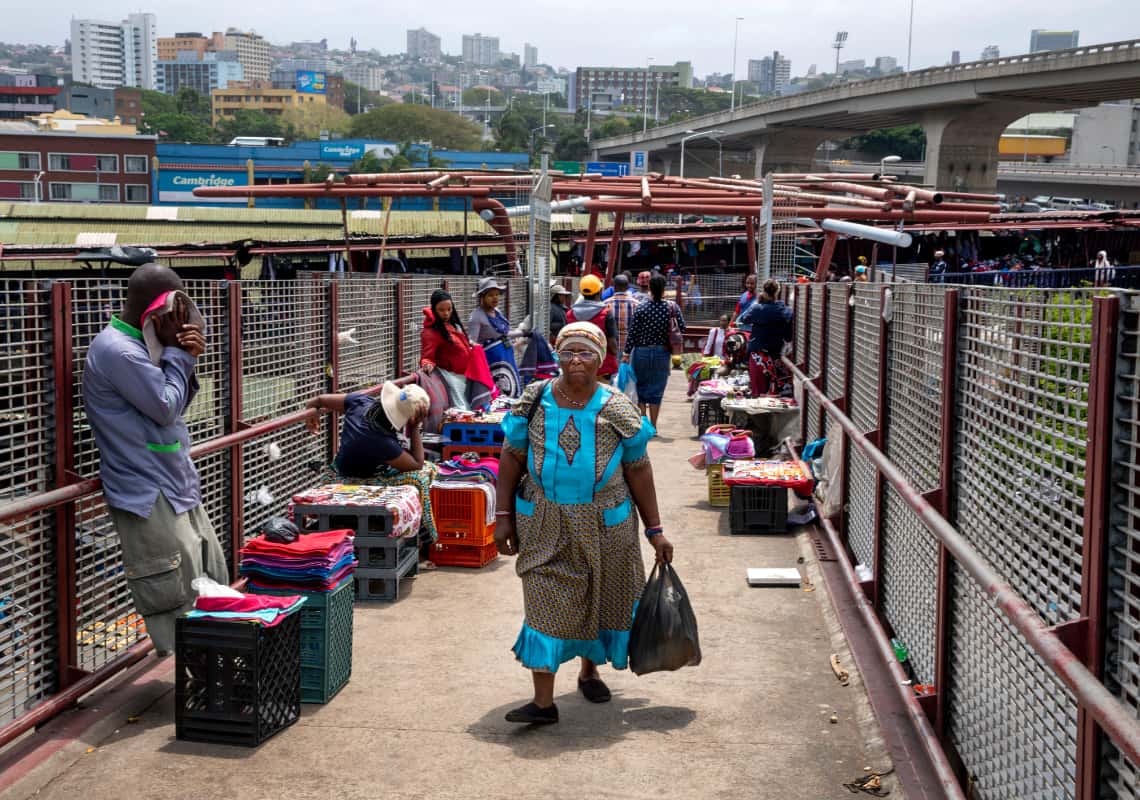
Worker stories from StreetNet: From fighting eviction and police harassment to building a better future through credit and microloans, organized street vendors improve their lives. Read the stories.
Vital Contributors to Urban Economies
Street vendors and market traders are an integral part of urban economies around the world, offering easy access to a wide range of affordable goods and services in public spaces. They sell everything from fresh vegetables to prepared foods, from building materials to garments and crafts, and from consumer electronics to auto repairs to haircuts.
E-BOOK: Street Vendors and Public Space: Essential insights on key trends and solutions (February 2020) – Through photography and text, this e-book offers an in-depth look at the important role street vendors play in cities, the challenges they face, and the solutions that can make cities more vibrant, secure, and affordable for all.
BLOG: Five Must-reads on Including Street Vendors in Public Spaces
TOOLKIT: Supporting Informal Livelihoods in Public Space: A Toolkit for Local Authorities
Contributions
WIEGO’s 2012 Informal Economy Monitoring Study (IEMS) revealed ways in which street vendors in five cities strengthen their communities:
- Most street vendors provide the main source of income for their households, bringing food to their families and paying school fees for their children.
- These informal workers have strong linkages to the formal economy. Over half of the interviewed workers said they source the goods they sell from formal enterprises. Many customers work in formal jobs.
- Many vendors try to keep the streets clean and safe for their customers and provide them with friendly personal service.
- Street vendors create jobs, not only for themselves but for porters, security guards, transport operators, storage providers, and others.
- Many generate revenue for cities through payments for licenses and permits, fees and fines, and certain kinds of taxes.
Street trade also adds vibrancy to urban life and in many places is considered a cornerstone of historical and cultural heritage.
Despite their contributions, street vendors face many challenges, are often overlooked as economic agents and unlike other businesses, are often hurt rather than helped by municipal policies and practices.
Statistical Snapshot
Street vendors sell goods and offer services in broadly defined public spaces, including open-air spaces, transport junctions and construction sites. Market traders sell goods or provide services in stalls or built markets on publicly or privately owned land (WIEGO Statistical Brief 8).
Street vendors are a large and very visible workforce in cities, yet it is difficult to accurately estimate their numbers (see Challenges of Obtaining Statistics on Street Vendors). The WIEGO Statistics Programme publishes data based on official statistics on both street vendors and market traders. In 2012, WIEGO published data on street trade in 11 cities in 10 countries (WIEGO Working Paper no.9). Street vendors and market traders are two of the worker groups in the more recent WIEGO Statistical Brief series on informal workers. The briefs present statistics on the numbers, the working arrangements and the characteristics of these two groups based on official statistics at the national, urban and city levels.
Street vendors and market traders are a significant proportion of the urban labour force in developing countries.
- Ghana (2015): 39 per cent of women and 10 per cent of men employed in urban Ghana are market traders; 5 per cent of women and 1 per cent of men are street vendors. Together, street vendors and market traders are 29 per cent of total urban employment (WIEGO Statistical Brief no.21).
- 8 Major South African Metro Areas (2018): 3 per cent of women and 2 per cent of men employed in these metro areas are street vendors; one per cent of both women and men are market traders. Together they comprise 2 per cent of employment in the areas (WIEGO Statistical Brief no.19).
- India (2017/18): 3 per cent of women and 5 per cent of men in urban employment are street vendors and market traders comprising 4 per cent of total urban employment (WIEGO Statistical Brief no.24); (2018/19): 4 per cent of women and 2 per cent of men in urban employment are street vendor and market traders, comprising around 4 per cent of total urban employment (see tables under ‘Additional Data for India’ here).
- Thailand (2017): 4 per cent of women and 3 per cent of men in urban employment are market traders; 3 per cent of women and 2 per cent of men in urban employment are street vendors, comprising 6 per cent of total urban employment (WIEGO Statistical Brief no.20).
- Mexico (2019): 3 per cent of women and 2 per cent of men in urban employment are market traders; 4 per cent of women and 3 per cent of men are street vendors. Together both comprise 6 per cent of urban employment (WIEGO Statistical Brief no.22).
- Peru (2015): 10 per cent of women in non-agricultural employment in urban Peru (outside of Lima) and 4 per cent of men are street vendors; 6 per cent of women and 2 per cent of men are market traders. Together the groups jointly comprise 11 per cent of non-agricultural urban employment outside of Lima (WIEGO Statistical Brief no.16).
Street Vending, Market Trade and Gender
The statistics above indicate that street and market trade are generally greater sources of employment for women than for men. Further, a higher share of women than men sell food and other perishable goods (Roever 2014; WIEGO Statistical Brief no.16), which are more likely than other goods to spoil or to be confiscated. Research also shows that women street vendors typically earn less than men—and, in many countries, less than half as much as men (Chen and Snodgrass 2001; WIEGO Statistical Brief no.16). The difference in earnings is not entirely explained by women working fewer hours than men. The Peru study found that although women market traders and street vendors worked fewer hours than men, the net hourly earnings of women were less than men’s for market traders and for street vendors in urban areas (other than Lima). Only women street vendors in Lima had slightly higher net hourly earnings than men (WIEGO Statistical Brief no.16).

Driving Forces & Working Conditions
Low barriers to entry, limited start-up costs, and flexible hours are some of the factors that draw street vendors to the occupation. Many people enter street vending because they cannot find a job in the formal economy.
But surviving as a street vendor requires a certain amount of skill. Competition among vendors for space in the streets and access to customers is strong in many cities. And vendors must be able to negotiate effectively with wholesalers and customers.
Street trade can offer a viable livelihood, but earnings are low and risks are high for many vendors, especially those who sell fresh fruits and vegetables (Roever 2014). Having an insecure place of work is a significant problem for those who work in the streets. Lack of storage, theft or damage to stock are common issues.
By-laws governing street trade can be confusing and licenses hard to get, leaving many street vendors vulnerable to harassment, confiscations and evictions. Learn more about Street Vendors and The Law.
Occupational Health and Safety
Working outside, street vendors and their goods are exposed to strong sun, heavy rains and extreme heat or cold. Unless they work in markets, most don’t have shelter or running water and toilets near their workplace. Inadequate access to clean water is a major concern of prepared food vendors.
Street vendors face other routine occupational hazards. Many lift and haul heavy loads of goods to and from their point of sale. Market vendors are exposed to physical risk due to a lack of proper fire safety equipment, and street vendors are exposed to injury from the improper regulation of traffic in commercial areas.
Insufficient waste removal and sanitation services result in unhygienic market conditions and undermine vendors’ sales as well as their health, and that of their customers.
Meet an indigenous caterer in a market in Accra, Ghana.
Vulnerability to Economic Downturns
The COVID-19 crisis has severely impacted vendors’ ability to earn a livelihood. Read more here.
COVID-19 was not the first crisis to hit street vendors hard. Economic downturns have a big impact on vendors’ earnings. In 2009, an Inclusive Cities research project found many street vendors reported a drop in consumer demand and an increase in competition as the newly unemployed turned to vending for income.
A second round of research, done in 2010, found demand had not recovered for most vendors, and many had to raise prices due to the higher cost of goods. Competition had increased further as large retailers aggressively tried to attract customers.
The 2012 Informal Economy Monitoring Study confirmed that rising prices and increased competition were still affecting street vendors in several cities. Vendors said their stock was more expensive, but they had difficulty passing on rising costs to consumers, who expect to negotiate low prices on the streets. More competition means vendors take home lower earnings.

Policies & Programmes
Street vending generates enormous controversy in cities throughout the world. Key debates about street vending involve registration and taxation, individual vs. collective rights, health and safety regulations – especially where food is involved – and urban planning and governance.
An analysis by WIEGO's Urban Policies team found street vendors face increased hostility worldwide as they vie for access to public space.
Urban policies and local economic development strategies rarely prioritize livelihood security for informal workers. Urban renewal projects, infrastructure upgrades and mega events routinely displace street vendors from natural markets, leaving the most vulnerable without a workplace.
Good practice documentation shows vendors can help with urban management challenges like crime and cleaning. Also, basic infrastructure – shelters, toilets, electricity and water – can both improve vendor work environments and make public space safer, more comfortable and aesthetically pleasing.
Some cities are working with street vendors’ organizations to formulate innovative policies, programmes and practices that enable vendors to have a voice in making their cities more inclusive.
Bangkok was a leader when it came to selling goods and services in public spaces both day and night. Vending in Public Space: The Case of Bangkok (Yasmeen and Nirathron 2014) examines how this arose, especially given the country’s evolving political and economic agenda. However, since 2014 the Bangkok Metropolitan Administration (BMA), under a military junta, has evicted tens of thousands of Bangkok vendors. Resistance by street vendors has been intense.
Organization & Voice
Membership-based organizations help street vendors navigate their relationship with the authorities, build solidarity and solve problems with other vendors. Several have developed innovative ways to work with cities to keep the streets clean and safe while gaining a secure livelihood for vendors. Key demands of organized street vendors and market traders include the provision of infrastructure – including designated and appropriately designed trading and storage space, as well as toilets; access to affordable water and electricity to support economic activities; social protection coverage; an end to harmful city regulations and practices; and inclusion in all levels of decision-making on matters that affect them.
A strategy pursued by street and market vendor organizations to achieve these demands is to insist that local authorities recognize them as bargaining partners, and agree on local negotiation forums. In support of this end WIEGO and StreetNet International produced a handbook on Collective Negotiations for Informal Workers as part of the Organizing in the Informal Economy: Resource Books for Organizers Series.
Examples of achievements include:
- The Self-Employed Women’s Association (SEWA) and the National Association of Street Vendors of India (NASVI) were instrumental in making India’s National Law on Street Vending a reality. This national law recognizes, regulates and protects the livelihoods of street vendors.
- In Durban, South Africa, street vendor organizations came together (supported by Asiye eTafuleni, StreetNet International, unions and other civil society organizations) to fight the demolition of the Warwick Junction market to make way for a formal mall. However, these market vendors are continuously under new threats and must maintain resilience and solidarity.
In 2000, national street and market vendor organizations came together globally to form StreetNet International, as a means of amplifying the voice of street and market vendors internationally. WIEGO was fully in support of the formation of SNI, and continues to work closely with it, providing technical and organizational support.
Learn more about Organizing & Organizations.
WIEGO Specialist
Caroline Skinner
Director Urban Policies Programme
Related Reading
- WIEGO Focal City Delhi and Social Design Collaborative. 2020. Street vending in times of COVID-19: GUIDELINES FOR STREET VENDORS. WIEGO
- Skinner, Caroline, Jenna Harvey, Sarah Orleans Reed. 2018. Supporting Informal Livelihoods in Public Space: A Toolkit for Local Authorities. WIEGO and Cities Alliance
- Roever, Sally. 2016. "Street Vendors and Cities." Environment and Urbanization. Vol 28, No. 2.
- Roever, Sally. 2014. IEMS Sector Report: Street Vendors. WIEGO.
- Herrera, Javier, Mathias Kuépié, Christophe J. Nordman,Xavier Oudin and François Roubaud. 2012. Informal Sector and Informal Employment: Overview of Data for 11 Cities in 10 Developing Countries. WIEGO.
- Pamhidzai H. Bamu, 2019. Street Vendors and Legal Advocacy: Reflections from Ghana, India, Peru, South Africa and Thailand (Resource Document).
- Carré. 2014. Location, Location, Location: The Life of a Refugee Street Barber in Durban, South Africa.
- Kumar, Randhir. 2012. The Regularization of Street Vending in Bhubaneshwar, India: A Policy Model. WIEGO Policy Brief (Urban Policies) No. 7.
See all publications about Street Vending.
